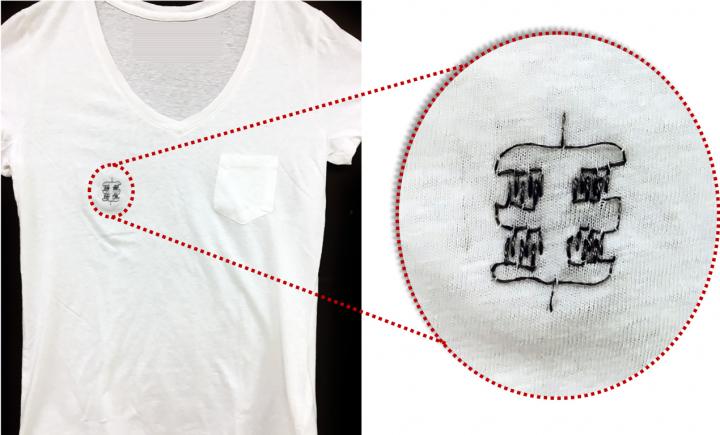Materials scientist creates fabric alternative to batteries for wearable devices

UMass Amherst researchers led by materials chemist Trisha L. Andrew report that they have developed a method for making a charge-storing system that is easily integrated into clothing for "embroidering a charge-storing pattern onto any garment." Credit: UMass Amherst/Trisha Andrew
A major factor holding back development of wearable biosensors for health monitoring is the lack of a lightweight, long-lasting power supply.
Now scientists at the University of Massachusetts Amherst led by materials chemist Trisha L. Andrew report that they have developed a method for making a charge-storing system that is easily integrated into clothing for “embroidering a charge-storing pattern onto any garment.”
As Andrew explains, “Batteries or other kinds of charge storage are still the limiting components for most portable, wearable, ingestible or flexible technologies. The devices tend to be some combination of too large, too heavy and not flexible.”
Their new method uses a micro-supercapacitor and combines vapor-coated conductive threads with a polymer film, plus a special sewing technique to create a flexible mesh of aligned electrodes on a textile backing.
The resulting solid-state device has a high ability to store charge for its size, and other characteristics that allow it to power wearable biosensors.
Andrew adds that while researchers have remarkably miniaturized many different electronic circuit components, until now the same could not be said for charge-storing devices.
“With this paper, we show that we can literally embroider a charge-storing pattern onto any garment using the vapor-coated threads that our lab makes. This opens the door for simply sewing circuits on self-powered smart garments.” Details appear online in ACS Applied Materials & Interfaces.
Andrew and postdoctoral researcher and first author Lushuai Zhang, plus chemical engineering graduate student Wesley Viola, point out that supercapacitors are ideal candidates for wearable charge storage circuits because they have inherently higher power densities compared to batteries.
But “incorporating electrochemically active materials with high electrical conductivities and rapid ion transport into textiles is challenging,” they add. Andrew and colleagues show that their vapor coating process creates porous conducting polymer films on densely-twisted yarns, which can be easily swelled with electrolyte ions and maintain high charge storage capacity per unit length as compared to prior work with dyed or extruded fibers.
Andrew, who directs the Wearable Electronics Lab at UMass Amherst, notes that textile scientists have tended not to use vapor deposition because of technical difficulties and high costs, but more recently, research has shown that the technology can be scaled up and remain cost-effective.
She and her team are currently working with others at the UMass Amherst Institute for Applied Life Sciences' Personalized Health Monitoring Center on incorporating the new embroidered charge-storage arrays with e-textile sensors and low-power microprocessors to build smart garments that can monitor a person's gait and joint movements throughout a normal day.
Media Contact
All latest news from the category: Materials Sciences
Materials management deals with the research, development, manufacturing and processing of raw and industrial materials. Key aspects here are biological and medical issues, which play an increasingly important role in this field.
innovations-report offers in-depth articles related to the development and application of materials and the structure and properties of new materials.
Newest articles

First-of-its-kind study uses remote sensing to monitor plastic debris in rivers and lakes
Remote sensing creates a cost-effective solution to monitoring plastic pollution. A first-of-its-kind study from researchers at the University of Minnesota Twin Cities shows how remote sensing can help monitor and…

Laser-based artificial neuron mimics nerve cell functions at lightning speed
With a processing speed a billion times faster than nature, chip-based laser neuron could help advance AI tasks such as pattern recognition and sequence prediction. Researchers have developed a laser-based…

Optimising the processing of plastic waste
Just one look in the yellow bin reveals a colourful jumble of different types of plastic. However, the purer and more uniform plastic waste is, the easier it is to…



